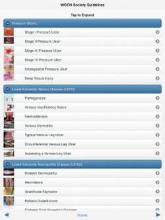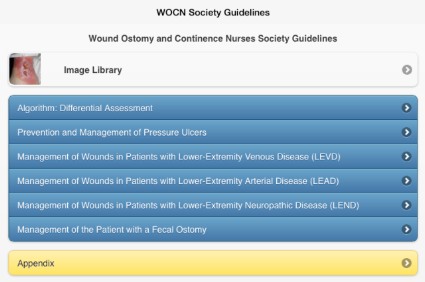User login
There are at least two ways to consider the meaning of evidence-based apps. One is a category of apps that have clinical trial evidence showing that they are useful, a topic we cover regularly in this column.
Another category, though, is apps that take existing evidence-based guidelines or already-vetted medical information and deliver that to you in a more efficient, convenient package.
One of the latest examples of the latter is the new Evidence-Based Wound Care Guidelines and Fecal Ostomy Best Practice app, sold by the Wound, Ostomy and Continence Nurses Society (WOCN) for iPhones, iPads, or iPod Touch devices. Is it worth the $60 price?
It would cost you at least $160 to buy print copies from the WOCN of the five guidelines included in the app, on management of patients with pressure ulcers, lower-extremity arterial disease (LEAD), lower-extremity neuropathic disease (LEND), lower-extremity venous disease (LEVD), and fecal ostomy.
Or, you could spend a fair amount of time finding and printing the equivalent guidelines in the archives of medical journals or online. The Agency for Healthcare Research and Quality (AHRQ) provides detailed summaries of most of these guidelines on its website, including the major recommendations in each guideline and ratings of the evidence behind those recommendations. You can find the AHRQ pages on management of pressure ulcers, LEND, LEVD, and fecal ostomy, for example. They’re free, but it’s a time-consuming process that leaves you with bulky printouts.
Alternatively, the WOCN offers a free, 12-page, quick-reference guide for management of lower-extremity venous, arterial, or neuropathic wounds that you can download and print for free or, alternatively, consult without printing.
All in all, that’s a lot of dead trees to carry around if you want to consult these guidelines while treating patients, unless you have a bulky desktop computer handy. Compare that with the convenience of pulling out your smartphone or tablet to consult the literature on best practices at the bedside, and you can see why knowledge-delivering apps have caught physicians’ imaginations.
How can you know that an app is delivering credible information? The easiest way is to choose an app from a credible organization, such as the Cancer.Net app for patients with cancer, from the American Society of Clinical Oncology. Apps that have been vetted by the likes of the Cleveland Clinic, Mayo Clinic, or Veterans Affairs Healthcare System, for example, typically have been assessed with some quality-control measures. Every app has its flaws, however, so it’s usually worth searching for reviews online to gauge the strengths and weaknesses of various apps, especially when there is more than one available on a particular topic.
For-profit companies have developed some of the most popular evidence-driven apps for physicians. UpToDate claims that its physicians, authors, and editors synthesize the available medical evidence so the app can provide recommendations in primary care, ob.gyn., pediatrics, general surgery, emergency medicine, internal medicine, and all of the internal medicine subspecialties, among others. An individual subscription costs $499/year.
Epocrates offers a free app that provides medication information and lets you look up drug interactions and more, with additional services for a fee. Other apps do the same – Lexicomp is one subscription-based app that allows a 30-day free trial.
How to choose? Again, reviews may be helpful. The physician-run site iMedicalApps compared several medical drug reference apps in a 2010 review, but in app development time, that already seems light-years ago.
If you don’t recognize a company as a credible player in delivering mobile medical information, you can take several steps to assess the app’s trustworthiness. When you look at the app’s description online or in your mobile device’s app store, often the description is short and doesn’t list the reference information that the app relies on, though that’s often included in the app itself.
You’ll find reviews and ratings in the app description, but take these with a grain of salt. These can be anonymous, reflect anecdotal experiences, and may be planted by the developer of the app to make it look good.
Click on the tab for the developer in the app description, and if you don’t recognize the name, make sure there’s a link to a website or at least an e-mail address so you can assess whether the developer has health care expertise.
It’s also worth clicking on the Updates or Version History tab to see if it’s been updated, because good-quality apps usually get frequent updates, typically at least every 6 months, several app consultants said in interviews.
Are you already using evidence-delivering apps? Which are your favorites? Let us know, and we may highlight them in a future column.
On Twitter @sherryboschert
There are at least two ways to consider the meaning of evidence-based apps. One is a category of apps that have clinical trial evidence showing that they are useful, a topic we cover regularly in this column.
Another category, though, is apps that take existing evidence-based guidelines or already-vetted medical information and deliver that to you in a more efficient, convenient package.
One of the latest examples of the latter is the new Evidence-Based Wound Care Guidelines and Fecal Ostomy Best Practice app, sold by the Wound, Ostomy and Continence Nurses Society (WOCN) for iPhones, iPads, or iPod Touch devices. Is it worth the $60 price?
It would cost you at least $160 to buy print copies from the WOCN of the five guidelines included in the app, on management of patients with pressure ulcers, lower-extremity arterial disease (LEAD), lower-extremity neuropathic disease (LEND), lower-extremity venous disease (LEVD), and fecal ostomy.
Or, you could spend a fair amount of time finding and printing the equivalent guidelines in the archives of medical journals or online. The Agency for Healthcare Research and Quality (AHRQ) provides detailed summaries of most of these guidelines on its website, including the major recommendations in each guideline and ratings of the evidence behind those recommendations. You can find the AHRQ pages on management of pressure ulcers, LEND, LEVD, and fecal ostomy, for example. They’re free, but it’s a time-consuming process that leaves you with bulky printouts.
Alternatively, the WOCN offers a free, 12-page, quick-reference guide for management of lower-extremity venous, arterial, or neuropathic wounds that you can download and print for free or, alternatively, consult without printing.
All in all, that’s a lot of dead trees to carry around if you want to consult these guidelines while treating patients, unless you have a bulky desktop computer handy. Compare that with the convenience of pulling out your smartphone or tablet to consult the literature on best practices at the bedside, and you can see why knowledge-delivering apps have caught physicians’ imaginations.
How can you know that an app is delivering credible information? The easiest way is to choose an app from a credible organization, such as the Cancer.Net app for patients with cancer, from the American Society of Clinical Oncology. Apps that have been vetted by the likes of the Cleveland Clinic, Mayo Clinic, or Veterans Affairs Healthcare System, for example, typically have been assessed with some quality-control measures. Every app has its flaws, however, so it’s usually worth searching for reviews online to gauge the strengths and weaknesses of various apps, especially when there is more than one available on a particular topic.
For-profit companies have developed some of the most popular evidence-driven apps for physicians. UpToDate claims that its physicians, authors, and editors synthesize the available medical evidence so the app can provide recommendations in primary care, ob.gyn., pediatrics, general surgery, emergency medicine, internal medicine, and all of the internal medicine subspecialties, among others. An individual subscription costs $499/year.
Epocrates offers a free app that provides medication information and lets you look up drug interactions and more, with additional services for a fee. Other apps do the same – Lexicomp is one subscription-based app that allows a 30-day free trial.
How to choose? Again, reviews may be helpful. The physician-run site iMedicalApps compared several medical drug reference apps in a 2010 review, but in app development time, that already seems light-years ago.
If you don’t recognize a company as a credible player in delivering mobile medical information, you can take several steps to assess the app’s trustworthiness. When you look at the app’s description online or in your mobile device’s app store, often the description is short and doesn’t list the reference information that the app relies on, though that’s often included in the app itself.
You’ll find reviews and ratings in the app description, but take these with a grain of salt. These can be anonymous, reflect anecdotal experiences, and may be planted by the developer of the app to make it look good.
Click on the tab for the developer in the app description, and if you don’t recognize the name, make sure there’s a link to a website or at least an e-mail address so you can assess whether the developer has health care expertise.
It’s also worth clicking on the Updates or Version History tab to see if it’s been updated, because good-quality apps usually get frequent updates, typically at least every 6 months, several app consultants said in interviews.
Are you already using evidence-delivering apps? Which are your favorites? Let us know, and we may highlight them in a future column.
On Twitter @sherryboschert
There are at least two ways to consider the meaning of evidence-based apps. One is a category of apps that have clinical trial evidence showing that they are useful, a topic we cover regularly in this column.
Another category, though, is apps that take existing evidence-based guidelines or already-vetted medical information and deliver that to you in a more efficient, convenient package.
One of the latest examples of the latter is the new Evidence-Based Wound Care Guidelines and Fecal Ostomy Best Practice app, sold by the Wound, Ostomy and Continence Nurses Society (WOCN) for iPhones, iPads, or iPod Touch devices. Is it worth the $60 price?
It would cost you at least $160 to buy print copies from the WOCN of the five guidelines included in the app, on management of patients with pressure ulcers, lower-extremity arterial disease (LEAD), lower-extremity neuropathic disease (LEND), lower-extremity venous disease (LEVD), and fecal ostomy.
Or, you could spend a fair amount of time finding and printing the equivalent guidelines in the archives of medical journals or online. The Agency for Healthcare Research and Quality (AHRQ) provides detailed summaries of most of these guidelines on its website, including the major recommendations in each guideline and ratings of the evidence behind those recommendations. You can find the AHRQ pages on management of pressure ulcers, LEND, LEVD, and fecal ostomy, for example. They’re free, but it’s a time-consuming process that leaves you with bulky printouts.
Alternatively, the WOCN offers a free, 12-page, quick-reference guide for management of lower-extremity venous, arterial, or neuropathic wounds that you can download and print for free or, alternatively, consult without printing.
All in all, that’s a lot of dead trees to carry around if you want to consult these guidelines while treating patients, unless you have a bulky desktop computer handy. Compare that with the convenience of pulling out your smartphone or tablet to consult the literature on best practices at the bedside, and you can see why knowledge-delivering apps have caught physicians’ imaginations.
How can you know that an app is delivering credible information? The easiest way is to choose an app from a credible organization, such as the Cancer.Net app for patients with cancer, from the American Society of Clinical Oncology. Apps that have been vetted by the likes of the Cleveland Clinic, Mayo Clinic, or Veterans Affairs Healthcare System, for example, typically have been assessed with some quality-control measures. Every app has its flaws, however, so it’s usually worth searching for reviews online to gauge the strengths and weaknesses of various apps, especially when there is more than one available on a particular topic.
For-profit companies have developed some of the most popular evidence-driven apps for physicians. UpToDate claims that its physicians, authors, and editors synthesize the available medical evidence so the app can provide recommendations in primary care, ob.gyn., pediatrics, general surgery, emergency medicine, internal medicine, and all of the internal medicine subspecialties, among others. An individual subscription costs $499/year.
Epocrates offers a free app that provides medication information and lets you look up drug interactions and more, with additional services for a fee. Other apps do the same – Lexicomp is one subscription-based app that allows a 30-day free trial.
How to choose? Again, reviews may be helpful. The physician-run site iMedicalApps compared several medical drug reference apps in a 2010 review, but in app development time, that already seems light-years ago.
If you don’t recognize a company as a credible player in delivering mobile medical information, you can take several steps to assess the app’s trustworthiness. When you look at the app’s description online or in your mobile device’s app store, often the description is short and doesn’t list the reference information that the app relies on, though that’s often included in the app itself.
You’ll find reviews and ratings in the app description, but take these with a grain of salt. These can be anonymous, reflect anecdotal experiences, and may be planted by the developer of the app to make it look good.
Click on the tab for the developer in the app description, and if you don’t recognize the name, make sure there’s a link to a website or at least an e-mail address so you can assess whether the developer has health care expertise.
It’s also worth clicking on the Updates or Version History tab to see if it’s been updated, because good-quality apps usually get frequent updates, typically at least every 6 months, several app consultants said in interviews.
Are you already using evidence-delivering apps? Which are your favorites? Let us know, and we may highlight them in a future column.
On Twitter @sherryboschert



